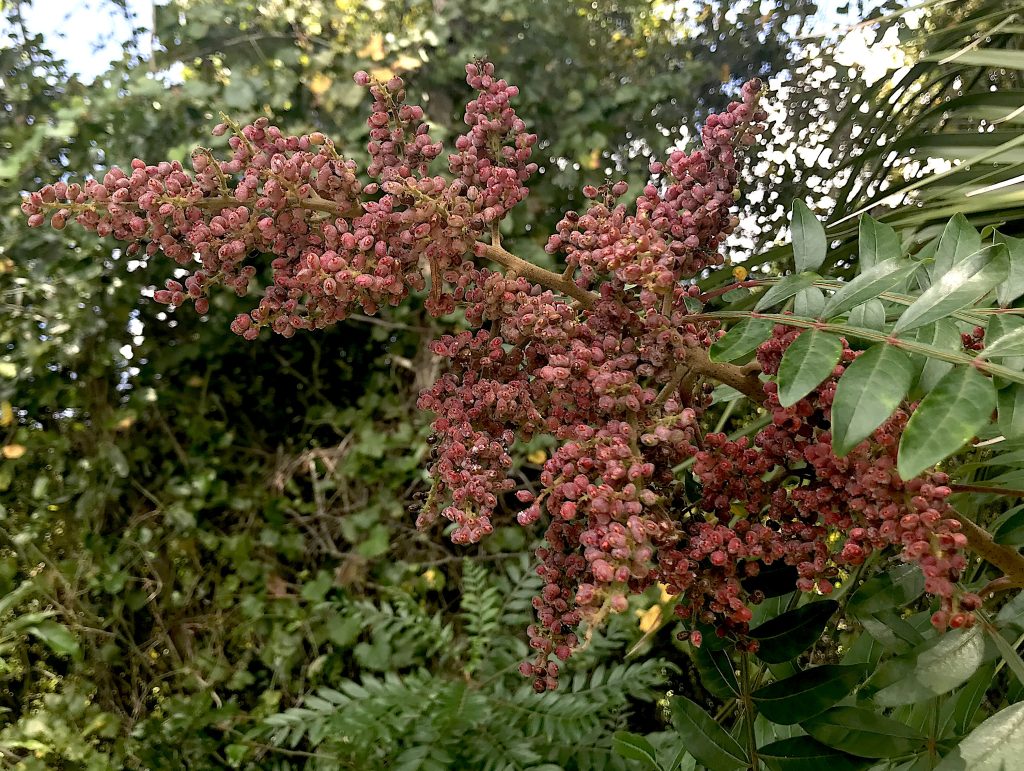
Damp and tart sumac berries in Cassadaga FL. Photo by Green Deane
It’s time to revisit sumac again. We found some very ripe and quite tart berries during our foraging classes this past weekend. The local sumac is Rhus copallina which is the most commonly found sumac in North America. I grew up with staghorn sumac which is far showier.
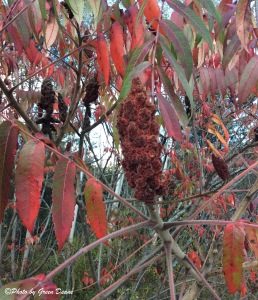
Tall, staghorn sumac in Maine. Photo by Green Deane
The acid that makes sumac tart is malic acid, which is the same acid that make apples tart. People in the past assumed it was ascorbic acid thus leading them to infer that sumacs have a lot of vitamin C which they do not. Their vitamin C contend is modest. However sumac are high in B vitamins. In fact, a report in the Pakistan Journal of Nutrition (2009 pages 1570-1574) says Sumac has half again more vitamin B6 than ascorbic acid. Why don’t we hear about Sumac being high in B6? The line up was B6 at 69.83 mgs per kilo; ascorbic acid 39.91 mgs per kilo.That is a good amount of vitamin C. But Sumac shines in other areas. As for the rest of B vitamins B1 (thiamin) was 30.65 mg; B2 (riboflavin) 24.68 mg; B3 (Niacin) 17.95 mg; B7 (biotin) 4.32 mg, and B12 (cyanocobalamin) 10.08 mg.
There is another edible part to the sumac: Young shoots, peeled. First year shoots off old stumps are the best, but the spring-time tips of old branches are also edible but not as good. Look at the end of a shoot after you break it off. If you see pith, which is an off-white core, it is too old. Break off that part then look again. You want a shoot stem that is all green inside. Then strip off the leaves and peel the shoot. You can eat it raw or cooked. They very purfume-ish and slightly astringent.
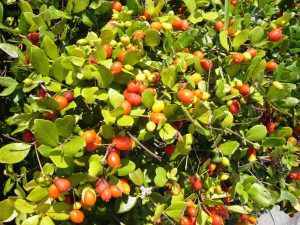
aSimpson Stoppers are quickly ripening. Photo by Green Deane
As mentioned in earlier newsletter Simpson Stopper berries are ripening. In the eucalyptus family, if you crush a leaf it does not smell of eucalyptus but rather citrusy, some think nutmeg, some think a piney lemon aroma. The blossoms are pleasantly fragrant, which helps you identify it from an unpleasant smelling relative, the Spanish Stopper. The sweet, mealy pulp of the orange red, ripe fruit is edible, tastes similar to marmalade with a little bit of bitter aftertaste. We don’t eat the seeds because they taste like an unripe Surinam Cherry.
The genus is closely related to Guavas as well as Syzigums and Eugenias. In the past many species were moved in and out of these genera and at one time M. fragrans was Eugenia simpsonii. In fact, this particular plant has had some 27 genus or species name changes. At the time E. simpsonii honored Charles Torrey Simpson, a naturalist and author in Miami in the early 1900’s.
While we can eat the berries there is a medicinal side. The main constituents of the essential oils of the Stopper are the monoterpene aldehydes geranial and neral. In antimicrobial tests the essential oils exhibited good activity against the Gram-negative bacteria, K. pneumoniae, and against the yeasts C. albicans and S. cerevisiae.
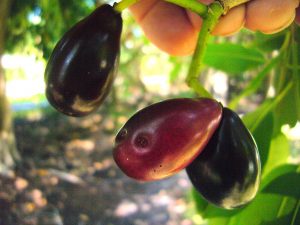
Even ripe Jambul fruit is slightly astringent. Photo by Green Deane
We picked Java Plums (Szygium cumini) this week right on schedule, (so to speak.) Depending upon the weather and location they tend to ripen from July to September. The owner of the tree didn’t like the flavor of the fruit and had scheduled it for removal so after our foraging class we paid a visit and carried home some of the astringent fruit.I’m making wine out of that. There are a few Jambuls in Orlando and certainly dozens in West Palm Beach. I know they also grow well in Sarasota and Port Charlotte where I think they are naturalized. Both Syzygium jambos and Syzygium samaragense are called the Rose Apple and Java Apple (and many other names as well.) There also is a Syzygium in your kitchen is S. aromaticum. You know the dried flower buds as “cloves.” As the species have been in foraging news lately I decided to bite the proverbial bullet and write a second article on the genus, or at least the latest one. You can read that article here and you can read about the Jambul here.
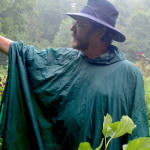
Classes are held rain or shine or cold…
Foraging Classes: Heading north Saturday for a rare class in Ocala then Suuday south of Daytona Beach.
Saturday September 17th, Jervey Gantt Recreation Complex, 2390 SE 36th Ave., Ocala, FL, 34471. 9 a.m. Meet at the entrance to the pool, aka Aquatic Fun Center. At this location this time of year I would expect to find some mushrooms.
Sunday September 18th. Spruce Creek Park, 6250 Ridgewood Ave. Port Orange, 32127. Meet at the pavilion 9 a.m.
Saturday September 24th,Blanchard Park, 10501 Jay Blanchard Trail, Orlando, FL 32817. 9 a.m. Meet by the tennis courts.
Sunday September 25th,George LeStrange Preserve, 4911 Ralls Road, Ft. Pierce. 9 a.m.
For more information, to pre-pay or to sign up for a class go here.
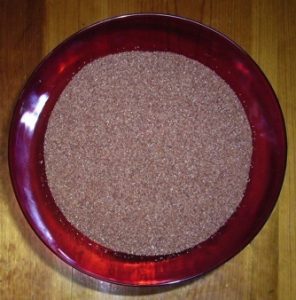
Crowfoot Grass seeds are gluten free. Photo by Green Deane
Crowfoot Grass, which is starting to ripen now, is not native to North America. It’s from Africa where the species is used to make unleavened bread and a frothy beer. While crowfoot grass is easy to harvest — when ripe — the grains are tiny, eye of a needle size. You can collect about two quarts an hour — making them calorie positive — and they can grow in large colonies making harvesting easy. Usually you collect the grains while sitting and using window screen plastic as a strainer. The grains have a small amount of cyanide in them but drying and cooking drives that off. Though minute botanically they are a mouthful: Dactyloctenium aegyptium. That means ‘little comb fingers from Egypt.’ You can find Crowfoot Grass from Maine to California skipping the upper northwest side of the country.

You get the USB, not the key.
Changing foraging videos: As my WordPress pages are being updated the video set will go away. They are the same videos I have on You Tube. Some people like to have a separate copy. The DVD format, however, is becoming outdated. Those 135 videos plus 36 more are now available on a USB drive. While the videos were played from the DVDs the videos on the USB have to be copied to your computer to play. They are MP4 files. The 171-video USB is $99. If you make a $99 “donation” using the link at the bottom of this page or here, that order form provides me with your address, the amount — $99 — tells me it is not a donation and is for the USB.

Green Deane Forum
Want to identify a plant? Perhaps you’re looking for a foraging reference? You might have a UFO, an Unidentified Flowering Object, you want identified. On the Green Deane Forum we — including Green Deane and others from around the world — chat about foraging all year. And it’s not just about warm-weather plants or just North American flora. Many nations share common weeds so there’s a lot to talk. There’s also more than weeds. The reference section has information for foraging around the world. There are also articles on food preservation, and forgotten skills from making bows to fermenting food.
This is weekly newsletter #523. If you want to subscribe to this free newsletter you can find the sign-up form in the menu at the top of the page.
To donate to the Green Deane Newsletter click here.

